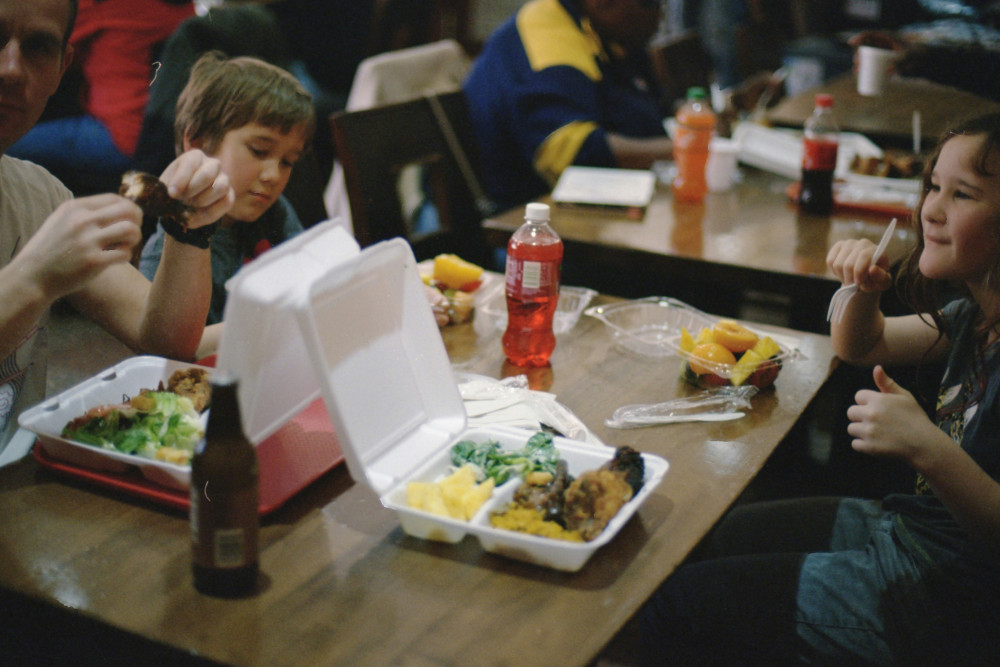Less than half of Richmond borough pupils are eligible for free school meals
By Tilly O'Brien 6th Jun 2025
By Tilly O'Brien 6th Jun 2025

The list of pupils eligible for free school meals in England by local area has been released, based on the percentage and number of students currently qualified.
The statistics vary from nearly half of the students in Manchester (47.2%) to about one in ten in Wokingham, Berkshire (10.2%) and just 3% on the Isles of Scilly.
The Department for Education (DfE) has released this data, which applies to upper-tier local authorities, from January 2025. The list is arranged by the percentage of students eligible for free meals.
In Richmond borough, only 14.1 per cent (4,078) pupils are eligible.
Pupils eligible for free school meals in England by local area:
- Manchester 47.2% (44,465)
- Islington 45.8% (10,590)
- Hackney 45.0% (14,619)
- Camden 44.8% (9,223)
- Birmingham 44.7% (92,105)
- Middlesbrough 43.3% (11,170)
- Tower Hamlets 43.3% (19,374)
- Westminster 42.1% (8,776)
- Blackpool 42.0% (8,326)
- Wolverhampton 42.0% (21,329)
- Newcastle upon Tyne 41.9% (17,932)
- Knowsley 41.9% (9,098)
- Stoke-on-Trent 39.9% (16,552)
- Southwark 39.8% (16,538)
- Halton 39.2% (7,230)
- Hartlepool 39.0% (5,887)
- Lambeth 38.6% (13,510)
- Nottingham 38.0% (18,784)
- Newham 37.9% (23,905)
- Southampton 37.9% (12,967)
- Salford 36.3% (14,096)
- Walsall 36.0% (19,551)
- Sandwell 36.0% (22,773)
- Kensington & Chelsea 35.6% (4,676)
- Portsmouth 35.5% (9,961)
- Tameside 35.1% (13,122)
- Derby 34.8% (16,153)
- Hull 34.7% (14,928)
- Oldham 34.3% (15,834)
- Sheffield 34.1% (29,096)
- Liverpool 34.0% (26,613)
- North East Lincolnshire 33.8% (7,923)
- South Tyneside 33.4% (7,703)
- Enfield 33.1% (18,131)
- Redcar & Cleveland 33.0% (6,862)
- Rochdale 32.9% (12,594)
- County Durham 32.7% (23,908)
- Wirral 31.6% (15,866)
- Sunderland 30.8% (12,899)
- North Lincolnshire 30.8% (7,402)
- Peterborough 30.5% (12,670)
- Wandsworth 30.5% (9,730)
- Bradford 30.4% (30,213)
- Greenwich 30.4% (13,468)
- Hammersmith & Fulham 30.2% (5,985)
- Bristol 30.2% (19,186)
- Croydon 29.9% (17,192)
- Doncaster 29.6% (14,407)
- Barnsley 29.4% (10,365)
- Derbyshire 29.1% (31,471)
- Rotherham 29.1% (13,203)
- Gateshead 29.0% (8,349)
- Wigan 28.9% (14,051)
- Stockton-on-Tees 28.8% (9,148)
- Lewisham 28.7% (10,819)
- Darlington 28.6% (4,614)
- Bolton 28.4% (15,473)
- St Helens 28.3% (7,634)
- Leicester 28.1% (17,044)
- Lincolnshire 28.0% (30,156)
- Coventry 28.0% (17,221)
- Telford & Wrekin 27.8% (9,057)
- Ealing 27.6% (15,092)
- Kirklees 27.5% (18,261)
- North Tyneside 27.2% (8,519)
- Calderdale 27.1% (9,583)
- Leeds 27.1% (35,841)
- Luton 27.1% (11,167)
- Dudley 26.8% (12,933)
- Barking & Dagenham 26.7% (12,329)
- Sefton 26.7% (10,766)
- Plymouth 26.5% (10,278)
- Merton 26.4% (7,287)
- Wakefield 26.3% (14,522)
- Brighton & Hove 26.3% (8,042)
- Haringey 26.3% (9,821)
- Torbay 26.3% (5,195)
- Blackburn with Darwen 25.6% (7,240)
- Waltham Forest 25.6% (10,687)
- Medway 25.5% (13,048)
- Isle of Wight 25.2% (4,049)
- Solihull 25.0% (9,915)
- Kent 24.9% (62,607)
- Lancashire 24.8% (44,194)
- Bury 24.8% (7,219)
- East Sussex 24.4% (16,460)
- Brent 24.3% (11,850)
- Milton Keynes 24.2% (12,695)
- Northumberland 23.8% (10,674)
- Hounslow 23.8% (10,851)
- Norfolk 23.4% (27,712)
- City of London 23.3% (58)
- Cornwall 23.1% (16,823)
- Warrington 23.1% (7,657)
- Thurrock 23.1% (7,322)
- Nottinghamshire 23.0% (29,221)
- Southend-on-Sea 22.9% (7,200)
- Hillingdon 22.8% (12,041)
- Suffolk 22.6% (23,349)
- Cambridgeshire 22.0% (20,298)
- Barnet 22.0% (13,625)
- Reading 21.9% (5,417)
- Bedford 21.9% (6,980)
- Warwickshire 21.8% (19,842)
- Cumberland 21.7% (8,574)
- Stockport 21.6% (9,436)
- Somerset 21.2% (15,285)
- North Northamptonshire 20.9% (11,805)
- Slough 20.9% (7,095)
- Staffordshire 20.8% (26,049)
- East Riding of Yorkshire 20.7% (9,257)
- Hampshire 20.7% (37,847)
- Devon 20.6% (20,508)
- Worcestershire 20.5% (16,892)
- Swindon 20.5% (7,676)
- Dorset 20.3% (9,597)
- Cheshire West & Chester% (20.2 10,322)
- Redbridge 20.1% (11,583)
- Essex 20.1% (44,874)
- Bournemouth, Christchurch & Poole 20.0% (10,557)
- Havering 19.9% (8,629)
- Herefordshire 19.7% (4,651)
- Bexley 19.4% (8,324)
- Shropshire 19.1% (7,551)
- Harrow 18.8% (7,307)
- Gloucestershire 18.6% (17,358)
- North Yorkshire 18.6% (15,127)
- York 17.6% (4,441)
- Bath & North East Somerset 17.5% (4,761)
- West Northamptonshire 17.3% (11,824)
- Trafford 17.3% (7,574)
- Leicestershire 17.2% (17,351)
- Wiltshire 17.1% (11,944)
- North Somerset 16.6% (5,242)
- Sutton 16.4% (6,740)
- Cheshire East 16.3% (9,348)
- Bromley 16.2% (8,606)
- Oxfordshire 16.1% (16,406)
- West Sussex 16.0% (18,983)
- South Gloucestershire 15.9% (6,623)
- West Berkshire 15.6% (4,140)
- Hertfordshire 15.5% (31,461)
- Buckinghamshire 15.4% (13,898)
- Westmorland & Furness 15.3% (4,684)
- Kingston upon Thames 15.2% (4,096)
- Windsor & Maidenhead 14.9% (3,420)
- Surrey 14.8% (24,215)
- Richmond upon Thames 14.1% (4,078)
- Central Bedfordshire 14.0% (6,914)
- Rutland 12.9% (760)
- Bracknell Forest 12.9% (2,441)
- Wokingham 10.2% (3,057)
- Isles of Scilly 3.2% (8)
Recent statistics indicate that over one in four students in England are now qualified for free school meals.
According to data released by the (DfE, an additional 77,700 children became eligible for free school meals within the past year.
As of January this year, the eligibility rate for free school meals was 25.7% of all students, which translates to 2.17 million children, an increase from 24.6%, or 2.09 million, in January 2024, as per the data.
These statistics emerge as the Government has revealed plans to extend free school meals to all students in England from families receiving universal credit starting September 2026.
At present, families in England on universal credit must have an income below £7,400 annually (after tax and excluding benefits) to be eligible for free school meals.
CHECK OUT OUR Jobs Section HERE!
twickenham vacancies updated hourly!
Click here to see more: twickenham jobs
Share:














